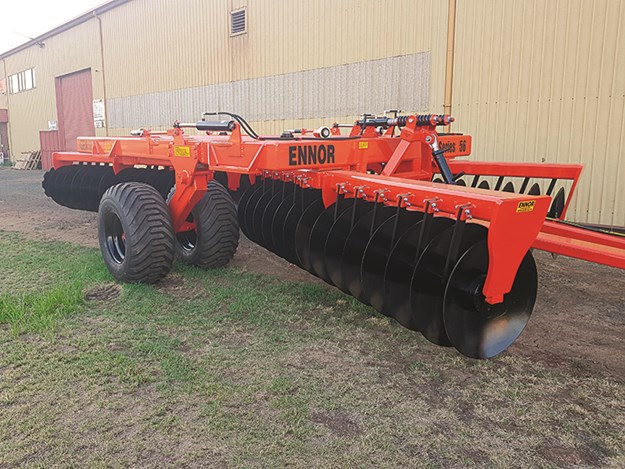Ennor Engineering has upgraded its ploughs with bulkier main frames and hardened pins on all pivots
Ennor Engineering’s latest product – the 32 Series 12.7 Gen II disc plough – has been sold to customers in multiple states since hitting the market last year.
It forms just one part of a rich and long history for Ennor Engineering, which is based in the southern New South Wales town of Deniliquin and manufactures its own products locally.
The family-owned company’s history dates to 1949 when it started life as a blacksmith shop, before shifting to manufacturing in the late 1970s.
The first disc implement to carry the Ennor brand was built in 1980 and was a 32-inch (81cm) machine, just as the newest disc plough is.
Plenty has changed in the past 40 years, of course, with more features being added to Ennor’s machines.
 |
|
The new Ennor Engineering 32 Series 12.7 Gen II disc plough
|
One upgrade on the 32 Series 12.7 Gen II compared to its predecessor is a heavier main frame, having increased from 200mm x 100mm x 12mm to 250mm x 150mm x 12.5mm rectangular hollow steel.
The gang frames have also been increased to 250mm x 150mm, with 12.5mm thickness for 32–48 plate models and 16mm thickness for 52–56 plate models. Other features include hardened pins on all pivots, large floatation tyres or optional aircraft tyres.
A stronger levelling control has also been fitted, which is hydraulic in operation. This features a level lift system that allows the operator to raise and lower the machine while keeping it level with a single control input.
Craig Ennor, who started with Ennor Engineering in 1995 and has owned the manufacturer since 2012, says there have also been new systems installed with the new model.
“The machines now come standard with greasable bearings which also incorporates a relief system to eliminate over-greasing,” he says.
“This system allows the operator to also ‘flush’ the bearing through with fresh grease, thus replacing the old grease as well as pushing through any contaminates. We have found this system to be very successful in extending bearing life as well as reducing maintenance intervals.
“Alternatively, there is the option of our oil-bath bearing system if required. The oil-bath system was developed completely in-house and over 5,000 hours of testing has been performed during its development.
“Every oil-bath hub we produce is test run and tested for temperature variations and torque, we then perform the first oil change before final assembly of the machine.”
.jpg) |
|
Upgrades include heavier, thicker frames
|
Another recent addition to the factory is an Okuma M660 vertical machining centre. This machine is equipped with a 26kW, 12,000rpm spindle, a work envelope of 1,500mm x 660mm x 660mm and is also fitted with a simultaneous fourth axis.
Ennor says the company also has the policy of updating its manufacturing equipment to not only offer consistent high-quality parts, but also to offer improved features on its machines at a competitive price.
He also says the company works closely with each customer to work out exactly which machine from an extensive range of options available will best suit them.
“Each machine is tailored to each customer depending on their specific requirement,” he says.
“We spend the time to understand what the customer is looking for and expecting from the machine, then we select the ideal model and specification to suit.
“We have over 500 base models and then there are many variations of each model.”

